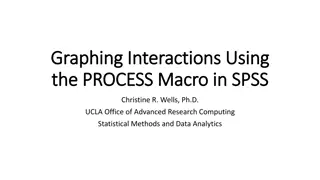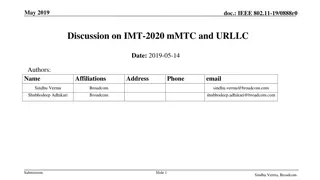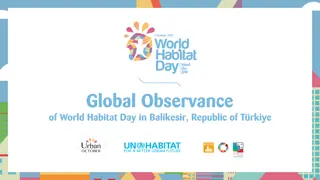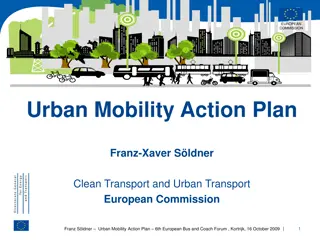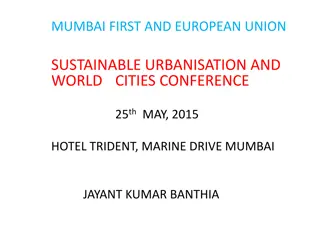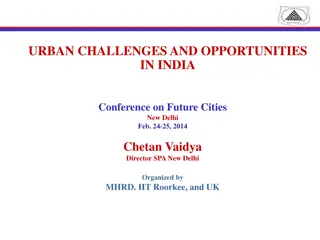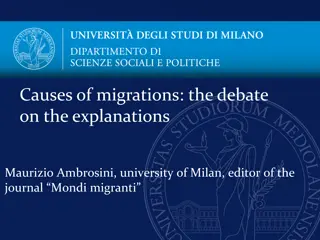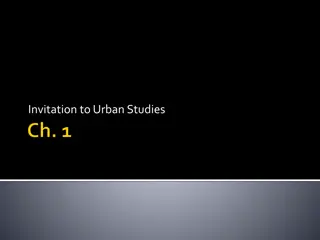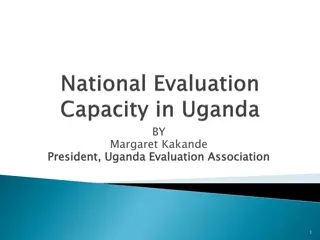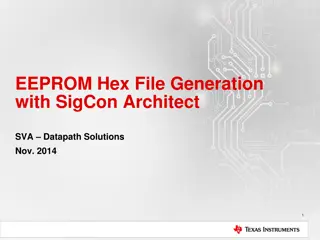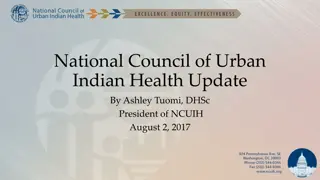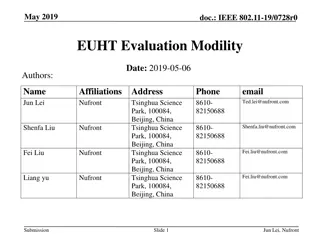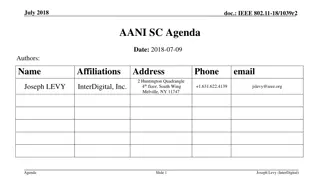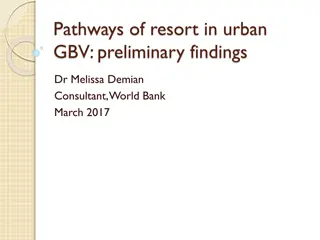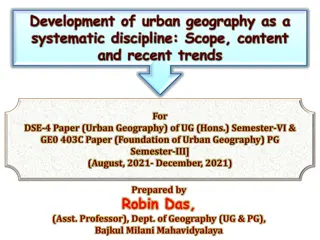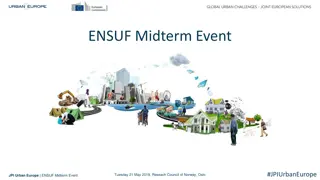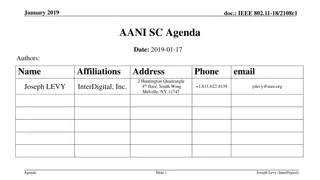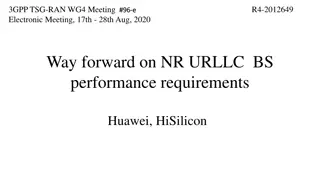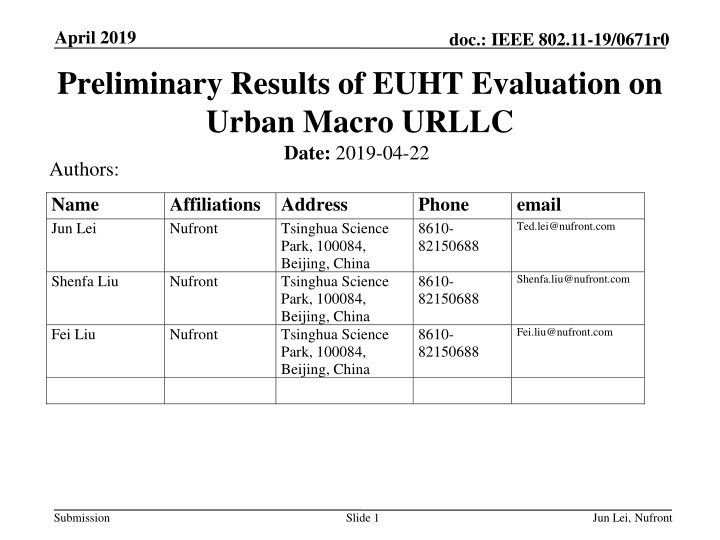
Preliminary Results of EUHT Evaluation in Urban Macro URLLC Scenario
This document presents the preliminary results of Enhanced Ultra High Throughput (EUHT) evaluation focusing on urban macro URLLC scenario according to ITU guidelines. The study shows that EUHT meets ITU requirements for this specific scenario, aiming towards IMT-2020 standardization. The presentation includes simulation configurations, assumptions, procedures, and outcomes, laying the groundwork for further advancements in radio interface technology.
Download Presentation

Please find below an Image/Link to download the presentation.
The content on the website is provided AS IS for your information and personal use only. It may not be sold, licensed, or shared on other websites without obtaining consent from the author. If you encounter any issues during the download, it is possible that the publisher has removed the file from their server.
You are allowed to download the files provided on this website for personal or commercial use, subject to the condition that they are used lawfully. All files are the property of their respective owners.
The content on the website is provided AS IS for your information and personal use only. It may not be sold, licensed, or shared on other websites without obtaining consent from the author.
E N D
Presentation Transcript
April 2019 Preliminary Results of EUHT Evaluation on Urban Macro URLLC Date: 2019-04-22 Authors: doc.: IEEE 802.11-19/0671r0 Name Jun Lei Affiliations Address Nufront Phone 8610- 82150688 email Ted.lei@nufront.com Tsinghua Science Park, 100084, Beijing, China Tsinghua Science Park, 100084, Beijing, China Tsinghua Science Park, 100084, Beijing, China Shenfa.liu@nufront.com Shenfa Liu Nufront 8610- 82150688 Fei.liu@nufront.com Fei Liu Nufront 8610- 82150688 Submission Slide 1 Jun Lei, Nufront
April 2019 doc.: IEEE 802.11-19/0671r0 Abstract This presentation is a follow up work of the proposal about joint submission to ITU as IMT-2020 standard [1]. In this contribution, we present the preliminary results of EUHT [2] simulations on urban macro URLLC scenario. The simulations adhere to the methodology specified by ITU-R for self-evaluating a RAT for IMT-2020 [3]. The preliminary results show that EUHT can meet the ITU requirements on urban macro URLLC scenario[4]. Submission Slide 2 Jun Lei, Nufront
April 2019 doc.: IEEE 802.11-19/0671r0 Abbreviation RIT ( Radio Interface Technology) URLLC Ultra-Reliable and Low Latency Communications eMBB enhanced Mobile Broadband mMTC (massive Machine Type Communication) 3GPP R15 3GPP Release 15 3GPP R16 3GPP Release 16 NSA Non-Standalone EUHT Enhanced Ultra High Throughput Submission Slide 3 Jun Lei, Nufront
April 2019 doc.: IEEE 802.11-19/0671r0 Outline Objective Simulation configuration Simulation assumptions Simulation procedure Results Conclusion Next Step References 1. 2. 3. 4. 5. 6. 7. 8. Submission Slide 4 Jun Lei, Nufront
April 2019 doc.: IEEE 802.11-19/0671r0 Objective In the previous meeting, it was proposed that 11ax and EUHT are combined together to be submitted to ITU as SRIT (set of RIT) [1]. In [1], EUHT is proposed to meet the requirements of the following scenarios Rural eMBB, Urban Marco URLLC and Urban Macro mMTC The self-evaluation results must be submitted together with the technical documents before July 1st according to ITU[5]. As the first step, the self-evaluation results of EUHT on urban URLLC scenario are shown in this contribution. Submission Slide 5 Jun Lei, Nufront
April 2019 doc.: IEEE 802.11-19/0671r0 Simulation Configuration 1. 2. 3. 4. 5. 6. Simulation bandwidth : 20 MHz Carrier Frequency: 4GHz BS Tx power : 23 dBm, UE Tx power: 23 dBm BS Antenna gain: 8 dBi, UE antenna gain: 0 dBi BS noise figure: 5 dB, UE noise figure : 7 dB BS antenna configuration : Omni uniform linear array 8Tx/8Rx with 8 dBi gain in intended direction. UE antenna configuration : Omni uniform linear array 8Tx/8Rx with with 0 dBi gain. The complete configuration is specified in the ITU-R guidelines for self-evaluating a RAT ([3]). 7. 8. Submission Slide 6 Jun Lei, Nufront
April 2019 doc.: IEEE 802.11-19/0671r0 Simulation Assumptions 1. Low overhead Control channel + Traffic channel 2. Control channel payload: 32 bit 3. TCH Payload : 32 Byte 4. QPSK, LDPC, 4/7 code rate, codeword size: 448 5. single spatial stream 6. Modulation symbol repetition in frequency domain 7. Realistic Channel Estimation 8. Maximum Ratio Combining 9. Min-sum LDPC decoding Submission Slide 7 Jun Lei, Nufront
April 2019 doc.: IEEE 802.11-19/0671r0 Simulation Procedure (1) The urban macro URLLC simulation procedure is quoted as follows [3] The evaluator shall perform the following steps in order to evaluate the reliability requirement using system-level simulation followed by link- level simulations. Step 1: Run downlink or uplink full buffer system-level simulations of candidate RITs/SRITs using the evaluation parameters of Urban Macro-URLLC test environment see 8.4.1 below, and collect overall statistics for downlink or uplink SINR values, and construct CDF over these values. Step 2: Use the CDF for the Urban Macro-URLLC test environment to save the respective 5th percentile downlink or uplink SINR value. Submission Slide 8 Jun Lei, Nufront
April 2019 doc.: IEEE 802.11-19/0671r0 Simulation Procedure (2) Step 3: Run corresponding link-level simulations for either NLOS or LOS channel conditions using the associated parameters in the Table 8-3 of this Report, to obtain success probability, which equals to (1- Pe), where Pe is the residual packet error ratio within maximum delay time as a function of SINR taking into account retransmission. Step 4: The proposal fulfils the reliability requirement if at the 5th percentile downlink or uplink SINR value of Step 2 and within the required delay, the success probability derived in Step 3 is larger than or equal to the required success probability. It is sufficient to fulfil the requirement in either downlink or uplink, using either NLOS or LOS channel conditions. Submission Slide 9 Jun Lei, Nufront
April 2019 doc.: IEEE 802.11-19/0671r0 System Level Simulation According to the simulation procedure, the system level simulation is mainly used to provide SINR statistics Because the system level simulation platform is not ready yet, we did not actually run the system level simulation to obtain the SINR values. The SINR CDF in [6] is adopted in the link level simulation as the 1st step, in which the 5th percentile value of SINR with the same condition is -1.72dB (from CATT). Therefore, the target of link level simulation is to achieve PER < 10e-5 @ -1.72dB SNR under small fading channel Submission Slide 10 Jun Lei, Nufront
April 2019 doc.: IEEE 802.11-19/0671r0 Link Level Simulation The total transmit power is normalized to 1 The IMT2020V2.0 ,http://www.zjhlab.net/publications/imt- 2020_cm_bupt/. small fading channel implementation is obtain from The channel model is UMA_A. The details of channel model parameters are aligned with ITU evaluation document [3]. Submission Slide 11 Jun Lei, Nufront
April 2019 doc.: IEEE 802.11-19/0671r0 Simulation Results Max Latency < 0.80ms PER < 10e-5 @ -3.5 SNR Submission Slide 12 Jun Lei, Nufront
April 2019 doc.: IEEE 802.11-19/0671r0 Conclusion The preliminary evaluation results show that EUHT can meet the requirements of URLLC of IMT-2020. Submission Slide 13 Jun Lei, Nufront
April 2019 doc.: IEEE 802.11-19/0671r0 Next Step In the next weeks, we will develop the system level simulation platform and perform more evaluation on URLLC/mMTC/rural eMBB. Submission Slide 14 Jun Lei, Nufront
April 2019 doc.: IEEE 802.11-19/0671r0 Reference [1] IEEE 802.11-19/0625r0, Proposal to Cooperate to Submit 5G Standards [2] IEEE 802.11-19/0626r0, EUHT Technical Brief [3] Report ITU-R M.2412-0 (10/2017), Guidelines for evaluation of radio interface technologies for IMT-2020 [4] Report ITU-R M.2410-0 (11/2017), Minimum requirements related to technical performance for IMT-2020 radio interface(s) [5] Report ITU-R M.2411-0 (11/2017) , Requirements, evaluation criteria and submission templates for the development of IMT-2020 [6] Document 5D/1050-E, Preliminary Description Template and Self- Evaluation of 3GPP 5G candidate for inclusion in IMT-2020 Submission Slide 15 Jun Lei, Nufront

